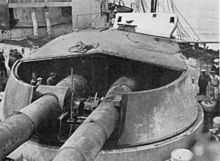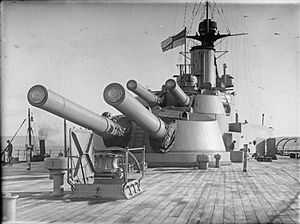BL 13.5-inch Mk V naval gun
| BL 13.5 inch Mk V gun | |
|---|---|
|
| |
| Type | Naval gun |
| Place of origin |
|
| Service history | |
| In service | 1912 - 1940s (as railway gun) |
| Used by |
|
| Wars |
World War I World War II |
| Production history | |
| Designer | Vickers |
| Designed | 1909 |
| Variants |
Mk V(L) Mk V(H) Mk VI |
| Specifications | |
| Barrel length | Bore 50 ft 6 in (15.392 m) (45 cal) |
|
| |
| Shell |
H: 1,400 lb (635.03 kg) L: 1,250 lb (566.99 kg) HE, AP[1] |
| Calibre | 13.5-inch (342.9 mm) |
| Elevation |
Naval: 0° - 20° Railway: 0° - 40° |
| Muzzle velocity |
H: 2,491 ft/s (759 m/s) L: 2,582 ft/s (787 m/s) |
| Maximum firing range |
H: 23,740 yards (21,710 m) at 20° L: 23,820 yards (21,780 m) at 20° H: 40,600 yards (37,120 m) at 40° (World War II railway gun, with Super Charge) |
The BL 13.5 inch Mk V gun[2] was a British heavy naval gun, introduced in 1912 as the main armament for the new super-dreadnought battleships of the Orion class. The calibre was 13.5 inches (343 mm) and the barrels were 45 calibres long i.e. 607.5 inches (15.43 m). The guns were greatly superior to the earlier 13.5-inch (30-calibre) Mk I to Mk IV guns used on the Admiral, Trafalgar and Royal Sovereign classes completed between 1888 and 1896.
Characteristics

The gun weighed approximately 168,000 lb (76 tonnes) (excluding the breech), and in its original form fired a 1,250 lb (567 kg) armour-piercing capped (APC) or high-explosive (HE) round a distance of 23,800 yards (21,800 m) at a 20-degree elevation.[3]
Variants
Due to the excellent characteristics of the gun, it was decided to increase the weight of shell to 1,400 lb (635 kg), with an increased firing charge to achieve about the same range. The gun firing the lighter shell was designated Mark V(L) (for "light") by the Royal Navy, and the 1,400 lb version Mark V(H) (for "heavy").[3] A very similar 1,400 lb gun, designed for the Ottoman battleship Reşadiye, received the designation Mark VI when the ship was requisitioned by the British government after the outbreak of the First World War, eventually being commissioned as HMS Erin.[4]
Railway guns
Three BL 13.5 inch /45 Mark V guns, named Gladiator, Piece Maker [sic] and Scene Shifter, were mounted on railway chassis during World War II for use as railway guns.[5] Scene Shifter re-used a railway truck which had carried a BL 14 inch Railway Gun in the First World War. In 1940 these guns were issued to the Royal Marine Siege Regiment at Dover in Kent to bombard German batteries and shipping in the Calais area.[6] They could be stored in railway tunnels when not in use to protect them from attack.
Service
British warships with the BL 13.5 inch /45 gun;
- Orion-class battleships: Mark V(L)
- King George V-class battleships of 1911: Mark V(H)
- Iron Duke-class battleships: Mark V(H)
- HMS Erin, a battleship: Mark VI
- Lion-class battlecruisers: Mark V(L)
- HMS Queen Mary, a battlecruiser : Mark V(H)
- HMS Tiger, a battlecruiser : Mark V(H)
See also
- 15 inch (381 mm) /42 calibre Mark I naval gun British successor
- List of naval guns
Weapons of comparable role, performance and era
- 340mm/45 Modèle 1912 gun French equivalent
Notes
- ↑ The gun had a Heavy (H) shell of 1,400 lb (640 kg) and a Light (L) shell of 1,250 lb (570 kg). Some guns were designated H or L to designated they were intended for the heavy or light shell.
- ↑ Mk V = Mark 5. Britain used Roman numerals to identify Marks (models) of ordnance until after World War II. This was the fifth model of British 13.5 inch gun
- ↑ navweaps.com - 13.5-in/45 Mark VI
- ↑ Dale Clarke. "British Artillery 1914-19. Heavy Artillery". Osprey Publishing, London, 2005. Pages 41-42
- ↑ http://www.doverpages.co.uk/big_guns.htm The Big Guns At Dover WW2 World War Two
References
External links
| Wikimedia Commons has media related to BL 13.5 inch Mk V naval gun. |
- Vickers Photographic Archives
- British 13.5"/45 (34.3 cm) Mark V(L) 13.5"/45 (34.3 cm) Mark V(H) at navweaps.com
| ||||||||||||||||||||||||||||||||||||||||||||||||||||||
